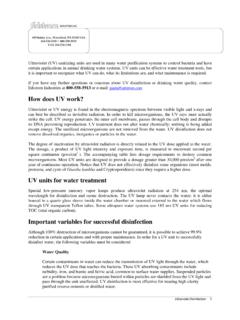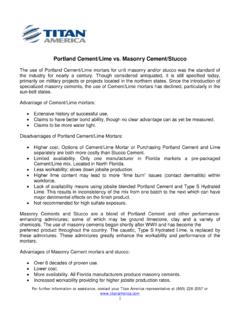Transcription of CFA Piling: Preventing ground & rig instability through ...
1 July 2014 - 1 - Federation of piling Specialists CFA piling : Preventing ground & rig instability through over-flighting July 2014 July 2014 - 2 - Federation of piling Specialists Contents Page 1. Introduction 3 2. Continuous Flight Auger piling 3 3. Overflighting mechanisms 4 4. Technical guidance and specifications 6 5. Control measures 7 6. Conclusions 8 7. References 8 Disclaimer: Although every effort has been made to check the accuracy of the information and validity of the guidance given in this document, neither the FPS nor its members accept any responsibility for mis-statements contained herein or misunderstanding arising herefrom. July 2014 - 3 - Federation of piling Specialists 1. Introduction The purpose of this document is to outline the key factors that may lead to settlement or instability of the piling rig when carrying out Continuous Flight Auger (CFA) piling as a result of over-flighting and to present best practice to mitigate these risks.
2 This document is not intended to replace the requirements to use competent supervision and operatives when carrying out CFA piling . This guidance will be of interest to piling contractors, geotechnical designers, CDM Co-ordinators and others concerned with the specification, selection and procurement of works involving piling . 2. Continuous Flight Auger piling CFA piling is a widely employed piling method offering both technical and commercial advantages, when used appropriately, in the right ground conditions and project circumstances. The method involves boring a continuous flight auger (CFA) drilling tool to the desired pile depth and then placing concrete through the tip of the auger tool as it is extracted from the ground . The method has the advantage that there is never an open or unsupported pile bore, as with some other bored piling methods.
3 If the auger tool is over-rotated and excessive soil removed, known as over-flighting", then the possibility exists for the ground around the tool to become unstable and ground settlement induced. This situation may be exacerbated if during the pile concreting operation an insufficient volume of concrete is placed ( less than the volume of soil removed during the pile boring). It is not uncommon for pile diameters of 900mm or greater to be used in CFA piling . Therefore even limited amounts of over-flighting can equate to significant volumes of ground loss. Certain geological formations increase the risk of over-flighting; in particular installing piles in soft ground overlying harder soils, silty sands and silts, and those with a high water table. Other factors include the cumulative effects when piles are spaced closely, such as in groups, and the power or torque of the piling rig s drill motor affecting relative rates of penetration and rotation.
4 Where such factors are properly identified and installation is carried out by competent operatives, under experienced supervision, the risks of over-flighting can be effectively managed. 3. Overflighting mechanisms To understand the reasons for over-flighting during CFA pile construction, it is first important to understand what happens in normal CFA construction and some details of the drilling tool or auger . The drilling tool comprises a hollow stemmed tube with a boring head or teeth at its tip. Over the entire length of the tube is a continuous helix of flights . The horizontal July 2014 - 4 - Federation of piling Specialists distance between the edges of the flights define the diameter of the pile and the vertical distance between the flights is the pitch, Figure 1. As the drilling tool or auger is bored and crowded (the vertical force exerted to assist penetration) into the ground , rotation slightly greater than one rotation per flight pitch is required to loosen the soil and allow the tool to penetrate.
5 In compressible soils it is possible to drill tight with minimal over rotation and minimal soil being transported to the surface. In stiffer and stronger soils greater rotation of the auger is required and more soil is rotated or flighted to the surface than the volume contained within the auger flights, Figure 2. The volume of flighted soil transported to the surface for one rotation depends on the diameter and shape of the auger, the soil type around it and the in-situ pressures in the ground . As the auger rotates, the loosened spoil is subject to an upward force imposed by the angled flights. The side friction prevents the soil from merely rotating within the flights. Where the auger has penetrated loose sands and gravels or soft cohesive ground , and then has to penetrate hard clays, dense sands or rocks at greater depth, the additional auger rotations needed to do this may transport too much of the weaker superficial soil up the auger, leading to soil being drawn into the auger leading to ground loosening, Figure 3.
6 This loosening of the soil can result in voids or settlement of the ground around the pile being formed. Undetected voids or excessive settlement below a piling platform may undermine the stability of the piling machine relying on its support. Specific conditions where there is an increased risk of over-flighting are described below. Figure 1. Typical details of Continuous Flight Auger drilling tool July 2014 - 5 - Federation of piling Specialists Figure 2. Optimum drilling where auger penetration with one rotation results in transported soil equal or marginally greater than the volume between the flights Figure 3. Slow auger penetration or over-rotation where soil transported is greater than the volume of soil contained between the flights per revolution Soft cohesive and cohesionless soil overlying firm to hard strata: The soil profile is seldom uniform.
7 Indeed it is often the case that loose and weak near-surface soil will overlie stronger soil that is more difficult to penetrate. In such situations difficulty in penetrating stronger material at depth can lead to over-rotation of the auger and over-flighting of near-surface soils. The harder material may be just the normal increase of strength with depth or may be as a result of natural obstructions (eg claystones in London Clay) or artificial obstructions ( old foundations). Soft clays, loose silts and sandy silts: These soils are prone to over-flighting and loose single sized sands have been noted as being susceptible to collapse during over-flighting. Identifying the risk requires good quality ground investigation data that properly characterises the soils. High water table: examples of rig instability have been cited on projects in London adjacent to the River Thames where a high water table has contributed to over-flighting.
8 This effect is caused by increased soil fluidity in weak submerged soil particles. Pile spacing and geometry: in cases where piles are being installed in groups, or at close spacings, the cumulative effects of flighting should be considered and where risks are considered high then local measures such as thickening of the piling platform or additional topping up may be required. piling platforms that have been reinforced with geogrid or have been stabilised with lime or cement are less likely to show surface settlement if there is excessive ground loss below and potentially could result in a brittle platform failure. July 2014 - 6 - Federation of piling Specialists 4. Technical guidance and specifications A number of common technical specifications identify the need to manage the risk of flighting.
9 The British Standard for the execution of special geotechnical works, BS EN 1536:2010 provides general advice for the construction of CFA piles: as follows: Boring with continuous flight augers shall be carried out in as short a time as possible and with the least practical number of auger rotations in order to minimise the effects on the surrounding ground . The 2007 second edition of the ICE Specification for piling and Embedded Retaining Walls (SPERW) also states: The piles shall be constructed using equipment capable of penetrating the ground to the design depth. Piles shall be constructed without drawing surrounding materials laterally into the pile bore. The pile shall be constructed in a manner to minimise the occurrence of flighting or heave of the ground such that no detrimental effects occur.
10 SPERW goes further, proposing minimum rates of penetration for typical soils: Excessive penetration resistance or flighting in typical soils may be defined as rate of penetration of less than 1m per 10 auger revolutions for standard or heavy duty CFA augers and could be less than 1m per 20 auger revolutions for extra heavy duty CFA augers. SPERW does not define a heavy or extra heavy duty auger dimensions however it is logical that augers with a larger central stem would need more rotations to transport a given volume of material up the flight. FPS members typically define a heavy duty auger as having a stem diameter of 150mm or greater. Although the advice in the above documents is helpful in bringing to attention the risks associated with flighting, they do not provide specific help or guidance on the selection of piling equipment and drilling tools, the particular high risk conditions and potential mitigation measures.







